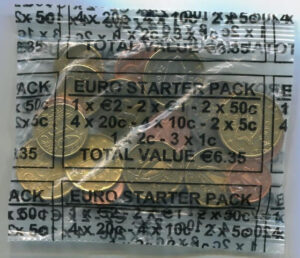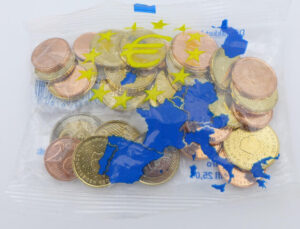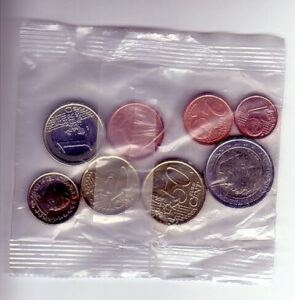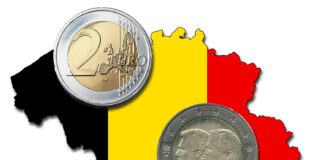
Besides Germany, fourteen other states introduced the euro as new currency on 1 January 2002. The starter kits, which are still popular among collectors today, were distributed among the citizens in various countries on different dates. Several particularities and curiosities can be observed regarding these packs of euro coins. In this article, we will take a look at them.
France, Ireland, Monaco and the Netherlands were the first countries to issue official starter kits on 14 December 2001. Belgium, Finland, Luxembourg, Austria and Spain followed on 15 December 2001. On 17 December 2001, Germany, Greece, Italy and Portugal issued their starter kits.
Vatican City only distributed sort of a starter kit among citizens and employees on 1 March 2002, after the introduction of the euro. However, the price of these small packs already had to be paid in euro. Strictly speaking, it seems to be incorrect to classify them as real starter kits – thus, they are only mentioned here for the sake of completeness. The Republic of San Marino is the only country that did not issue starter kits. Additionally, several banks in many countries – for example in Germany – made their own starter kits for various reasons. However, this article will only discuss official starter kits.

Starter Kits of Belgium
A total of 5,300,000 starter kits was distributed among the citizens as of 15 December 2001. Kits worth €12.40 were issued at a price of BEF500.00 (Belgian francs). The coins in these packs were minted in different years (starting with 1999). Today, such starter kits are worth €18 to €26.
Additionally, 2,000 official starter coin sets in blister packs were issued on 15 December 2001 by the then Belgian Minister of Finance at a meeting of the European Council. These packs exclusively contained coins made in 1999 and 2000. They are very rare and being sold at collector’s prices.

Starter Kits of Finland
A total of 500,000 starter kits was distributed among the citizens as of 15 December 2001. Kits worth €3.88 were issued at a price of FIM23.00 (Finnish markka). The coins in these packs were minted in different years (starting with 1999). The amount of produced kits was not very high and today such starter kits are worth €25 to €35.

Starter Kits of France
A total of 53,000,000 starter kits was distributed among the citizens as of 14 December 2001. Kits worth €15.25 were issued at a price of FRF100.00 (French francs). The coins in these packs were minted in different years (starting with 1999). Today, such starter kits are worth €18 to €30. In some starter kits, 1 cent pieces minted in 2002 were found. However, that is no reason for a higher price.

Starter Kits of Greece
A total of 3,000,000 starter kits was distributed among the citizens as of 17 December 2001. Kits worth €14.67 were issued at a price of GRD5000.00 (Greek drachma). The coins in these packs were minted in 2002 solely by foreign mints. These pieces can be identified thanks to the sign of the foreign mint engraved at the position of the stars of the European Union next to the year of mintage (2002). Today, such starter kits are worth €30 to €45.

Starter Kits of Ireland
A total of 750,000 starter kits was distributed among the citizens as of 14 December 2001. Kits worth €6.35 were issued at a price of IEP5.00 (Irish pounds). The coins in these packs were all minted in 2002. Today, such starter kits are worth €15 to €30.

Starter Kits of Italy
A total of 30,000,000 starter kits was distributed among the citizens as of 17 December 2001. Kits worth €12.91 were issued at a price of ITL25.000 (Italian lira). The coins in these packs were all minted in 2002. Today, such starter kits are worth €15 to €30.
Additionally, starter kits with the coat of arms of the Republic of Italy and the logo of the mint IPZS in Rome printed on them were produced. Today, such kits are worth €25 to €35. Starter kits without the imprint are worth €20 to €25.

Starter Kits of Luxembourg
A total of 599,486 starter kits was distributed among the citizens as of 15 December 2001. Kits worth €12.40 were issued at a price of LUF500.00 (Luxembourg francs). The coins in these packs were all minted in 2002. Today, such starter kits are worth €15 to €22.
Starter Kits of Monaco
A total of 51,200 starter kits was distributed among the citizens as of 14 December 2001. Kits worth €15.25 were issued at a price of FRF100.00 (French francs). The coins in these packs were all minted in 2001. Today, one has to pay 500 euros – at least – in order to purchase such a starter kit.

Starter Kits of the Netherlands
A total of 8,800,000 starter kits was distributed among the citizens as of 14 December 2001. Kits worth €11.35 were issued at a price of NLG25.00 (Dutch guilder). The coins in these packs were minted in different years (starting with 1999). Today, such a starter kit – also called “large starter kit” – is worth €20 to €35.

There was a second starter kit, which was distributed free of charge between 14 December and 31 December 2001 among all citizens of the Netherlands that were at least 6 years old. In order to receive the starter kit, one had to show a voucher that had been sent by post to the citizens. Each card folder contains one coin of every kind (1 cent to 2 euros = EUR3.88). The coins were made in different years (starting with 1999). Today, such starter kits in a card folder are worth €10 to €20. Please be sure that the foil is not damaged. You should not pay more than 5 euros for a starter kit that has already been opened.

Starter Kits of Austria
A total of 6,000,000 starter kits was distributed among the citizens as of 15 December 2001. Kits worth €14.54 were issued at a price of ATS200.00 (Austrian schilling). The coins in these packs were all minted in 2002. Such starter kits are worth €15 to €22.

Starter Kit of Portugal
A total of 1,000,000 starter kits was distributed among the citizens as of 17 December 2001. Kits worth €10.00 were issued at a price of PTE2005.00 (Portuguese escudos). The coins in these packs were all minted in 2002. Such starter kits are worth €20 to €25. In most cases, the coins of these official starter kits were inside of a small bag made of foil that did not bear an imprint.
We also know about other starter kits bearing an imprint that were also issued in Portugal. However – just like the so-called starter kits of the national postal service of Portugal and the starter kits of several banks – these are starter kits produced by private entities.
Starter Kits of San Marino
The Republic of San Marino did not issue starter kits.

Starter Kits of Spain
A total of 24,330,000 starter kits was distributed among the citizens as of 15 December 2001. Kits worth €12.02 were issued at a price of ESP2000.00 (Spanish pesetas). The coins in these packs were minted in different years (starting with 1999). Such starter kits are worth €15 to €20.
We also know about other starter kits of Spain. However, these are starter kits produced by private entities.

Starter Sets of Vatican City
The starter sets of Vatican City are quite special. To begin with, it is incorrect to classify these small plastic bags as starter kits. Most administrations and offices are located at the Governor’s Palace of Vatican City, right behind St. Peter’s Basilica in the Vatican Gardens. That is where you can find the UFN, which is responsible for the coin and stamp issues of Vatican City. At first, the UFN did not think about issuing a starter kit on the occasion of the introduction of the euro. In the Vatican, then as now, you find almost exclusively Italian coins in circulation. Although coins produced by Vatican City do exist, in most cases they are made for collectors only and are rarely found in circulation. And that is exactly what happened when the euro was introduced in 2002. The first euro coins featuring the portrait of Pope John Paul II became – due to the low mintage – greatly sought-after among collectors of the entire world. That is why the Vatican wanted to provide at least the citizens and employees of Vatican City with a loose set of the first euro coins. It was meant to be a souvenir, nothing else. Therefore, nuns filled and sealed 5,000 small plastic bags in the premises of the UFN. Absolutely unadorned and without an imprint. The small bags were issued on 1 March 2002 at a price of EUR3.88. As a souvenir for citizens and employees. However, collectors made these plastic bags become “starter kits”! Provided you want to classify them as such, these bags are the only starter kits that had to be sold at euro prices due to the late issuing date.
In the beginning, prices rocketed and today you still have to pay between €700 and €1000 in order to purchase one of them. In contrast, the first official FDC coin set of Vatican City in an official card folder is available for €240.
One thing is for sure: these plastic bags do not have any particular features and you can easily make them by yourself. No doubt many “specialists” took the coins out of official coin sets and put them into sealed plastic bags. If you take a look at some auctions on the Internet, strangely enough, you will find a lot of empty Vatican card folders from 2002. I do not believe that the missing coins have simply been lost or spent. That is why I think such a “starter kit” is only worth the current price of an official coin set containing the same coins. I would not – and you should not – spend more on such a set.
This German article summarizes the reaction of the German public on the starter packs.
BBC reported on the challenges of launching the euro.
You can find numerous articles on the subject of euro coins in our archive.



